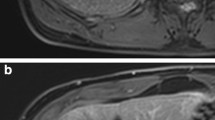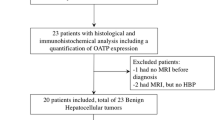Abstract
Introduction
This study evaluates 18F-FDG PET/CT imaging characteristics of pathologically proven hepatocellular adenoma (HCA) subtypes.
Methods
This is a retrospective review of an institutional database (2011–2017) for subjects with a pathologic diagnosis of hepatic adenomas established within 6 months of a pre-treatment 18F-FDG PET/CT exam. An expert pathological review by a hepatopathologist was performed to confirm diagnosis and subtype HCA. A review of the 18F-FDG PET/CT exams was performed by two board-certified nuclear radiologists in consensus. Corresponding demographic and clinical data were obtained by electronic chart review.
Results
Nine subjects were identified. An HCA subtype was established in seven subjects (4 HNF1A-mutated and 3 Inflammatory). The mean HCA lesion size was 2.8 cm (range 0.6–6.2, SD 2.0) with a mean SUVmax of 5.9 (range 2.1–18.9, SD 5.1). The SUV values of HNF1A-mutated HCA were significantly higher than inflammatory HCA: lesion SUVmax (5.3 ± 1.48 vs. 2.8 ± 0.59, p < 0.033), lesion-to-liver SUVmax ratio (1.4 ± 0.22 vs. 0.8 ± 0.21, p = 0.031), lesion SUVmean (3.6 ± 0.37 vs. 2.0 ± 0.46, p = 0.0086).
Conclusion
HNF1A-mutated HCA may have greater SUV values than inflammatory HCA on 18F-FDG PET/CT exams. However, there are contradictory data in the literature and further investigation is warranted.


Similar content being viewed by others
References
Cho SW, Marsh JW, Steel J, et al. Surgical management of hepatocellular adenoma: take it or leave it? Ann Surg Oncol. 2008;15:2795-803.
Stoot JH, Coelen RJ, De Jong MC, et al. Malignant transformation of hepatocellular adenomas into hepatocellular carcinomas: a systematic review including more than 1600 adenoma cases. HPB (Oxford). 2010;12:509-22.
van Aalten SM, de Man RA, I. Jzermans JN, et al. Systematic review of haemorrhage and rupture of hepatocellular adenomas. Br J Surg. 2012;99:911–6.
Bioulac-Sage P, Balabaud C, Zucman-Rossi J. Subtype classification of hepatocellular adenoma. Dig Surg. 2010;27:39-45.
Nault JC, Couchy G, Balabaud C, et al. Molecular Classification of Hepatocellular Adenoma Associates With Risk Factors, Bleeding, and Malignant Transformation. Gastroenterology. 2017;152:880-894.
Young JT, Kurup AN, Graham RP, et al. Myxoid hepatocellular neoplasms: imaging appearance of a unique mucinous tumor variant. Abdominal Radiology. 2016; 41:2115-2122.
Salaria SN, Graham RP, Aishima S, et al. Primary hepatic tumors with myxoid change: morphologically unique hepatic adenomas and hepatocellular carcinomas. Am J Surg Pathol. 2015;39:318-24.
Mounajjed T, Yasir S, Aleff PA, et al. Pigmented hepatocellular adenomas have a high risk of atypia and malignancy. Mod Pathol. 2015;28:1265-74.
Sumiyoshi T, Moriguchi M, Kanemoto H, et al. Liver-specific contrast agent-enhanced magnetic resonance and 18F-fluorodeoxyglucose positron emission tomography findings of hepatocellular adenoma: report of a case. Surg Today. 2012;42:200-4.
Fosse P, Girault S, Hoareau J, et al. Unusual uptake of 1818F-FDG by a hepatic adenoma. Clin Nucl Med. 2013;38:135-6.
Lim D, Lee SY, Lim KH, et al. Hepatic adenoma mimicking a metastatic lesion on computed tomography-positron emission tomography scan. World J Gastroenterol. 2013;19:4432-6.
Nakashima T, Takayama Y, Nishie A, et al. Hepatocellular adenoma showing high uptake of (18)F-fluorodeoxyglucose (FDG ) via an increased expression of glucose transporter 2 (GLUT-2). Clin Imaging. 2014;38:888-91.
Ozaki K, Harada K, Terayama N, et al. Hepatocyte nuclear factor 1alpha-inactivated hepatocellular adenomas exhibit high 18F-fludeoxyglucose uptake associated with glucose-6-phosphate transporter inactivation. British Journal of Radiology. 2016;89:1063.
Lee S, Kingham T, LaGratta M, et al. PET-avid hepatocellular adenomas: incidental findings associated with HNF1-α mutated lesions. HPB. 2016;18:41-48.
Buc E, Dupre A, Golffier C, et al. Positive PET-CT scan in hepatocellular adenoma with concomitant benign liver tumors. Gastroenterol Clin Biol. 2010;34:338-41.
Liu W, Delwaide J, Bletard N, et al. 18-Fluoro-deoxyglucose uptake in inflammatory hepatic adenoma: A case report. World J Hepatol. 2017;9:562-566.
Sureka B, Rastogi A, Mukund A, et al. False-positive (18)F fluorodeoxyglucose positron emission tomography-avid benign hepatic tumor: Previously unreported in a male patient. Indian J Radiol Imaging. 2018;28:200-204.
Patel PM, Alibazoglu H, Ali A, et al. 'False-positive' uptake of 18F-FDG in a hepatic adenoma. Clin Nucl Med. 1997;22:490-1.
Delbeke D, Martin WH, Sandler MP, et al. Evaluation of benign vs malignant hepatic lesions with positron emission tomography. Arch Surg. 1998;133:510-5.
Stephenson JA, Kapasi T, Al-Taan O, et al. Uptake of (18) 18F-FDG by a Hepatic Adenoma on Positron Emission Tomography. Case Reports Hepatol. 2011;276402:1-4.
Sanli Y. Bakir B, Kuyumcu S, et al. Hepatic adenomatosis may mimic metastatic lesions of liver with 18F-FDG PET/CT. Clin Nucl Med. 2012;37:697-8.22.
Magini G, Farsad M, Frigerio M, et al. C-11 acetate does not enhance usefulness of 18F-FDG PET/CT in differentiating between focal nodular hyperplasia and hepatic adenoma. Clin Nucl Med. 2009;34:659-65.
Zucman-Rossi J, Jeannot E, Nhieu JT, et al. Genotype-phenotype correlation in hepatocellular adenoma: new classification and relationship with HCC. Hepatology. 2006;43:515-24.
Doolittle DA, Atwell TD, Sanchez W, et al. Safety and Outcomes of Percutaneous Biopsy of 61 Hepatic Adenomas. AJR Am J Roentgenol. 2016;206:871-6.
Author information
Authors and Affiliations
Corresponding author
Ethics declarations
Conflict of interest
No potential conflicts of interest or funding associated with this work.
Additional information
Publisher's Note
Springer Nature remains neutral with regard to jurisdictional claims in published maps and institutional affiliations.
Rights and permissions
About this article
Cite this article
Young, J.R., Graham, R.P., Venkatesh, S.K. et al. 18F-FDG PET/CT of hepatocellular adenoma subtypes and review of literature. Abdom Radiol 46, 2604–2609 (2021). https://doi.org/10.1007/s00261-021-02968-2
Received:
Revised:
Accepted:
Published:
Issue Date:
DOI: https://doi.org/10.1007/s00261-021-02968-2




